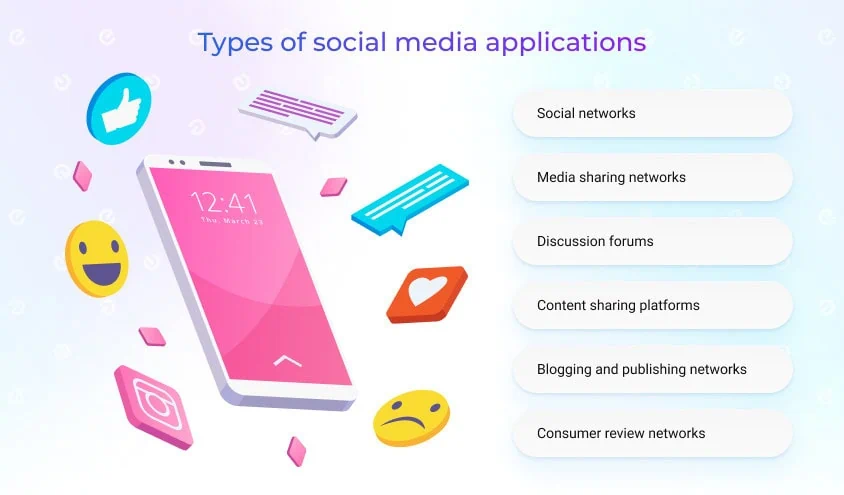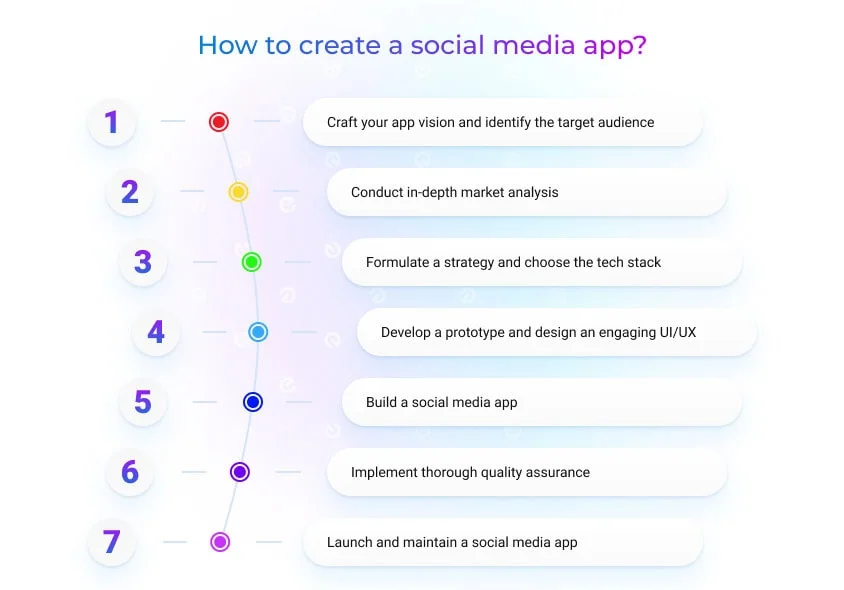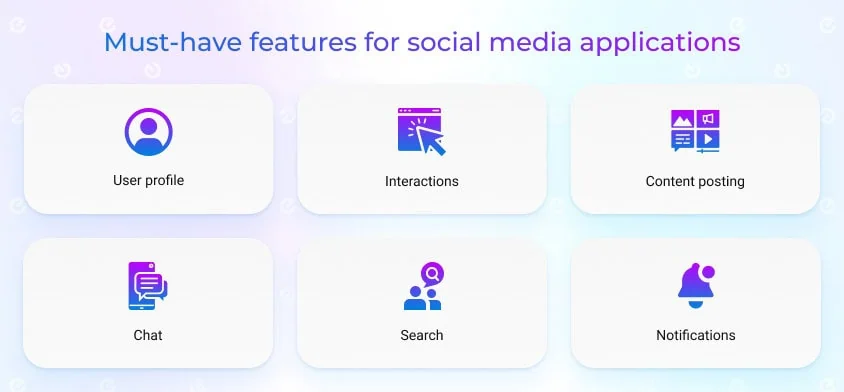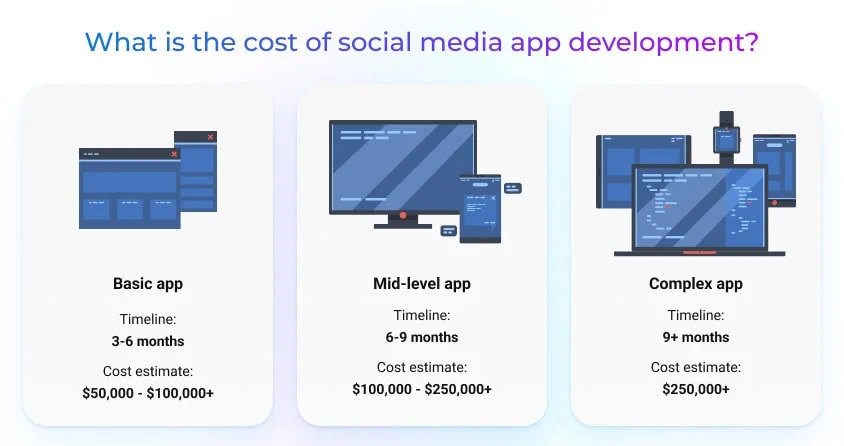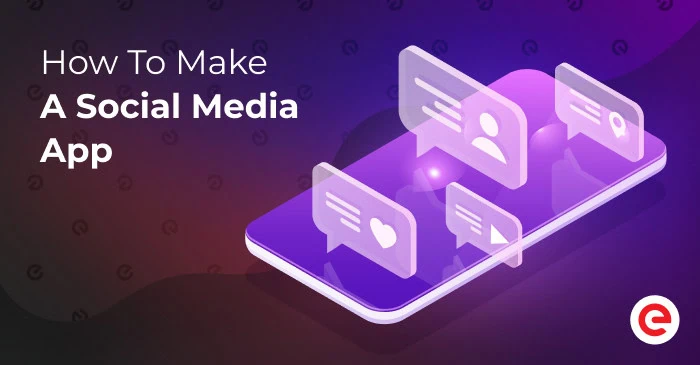
Updated: July 18, 2024
Published: July 18, 2024
Why would some want to make a social media app in 2024? How can a new social network withstand the market competition and introduce cutting-edge features to attract users? Check out the article on how to make a social media app with insights on the development process, essential functionalities, and valuable tips to make your app stand out.
List of the Content
- Why make a social media app in 2024?
- What type of social media app to choose?
- How to make a social media app?
- How to build a social media app and engage users with the proper functionality?
- How much does it cost to create a social media app?
- Monetization models
- Conclusion
Key takeaways
- The social media app can launched from scratch in 6-9 months on average, depending on the project’s complexity and feature set.
- The development cost is estimated to be between $50,000 and $250,000.
- The strategic approach allows teams to target user needs with diverse social media app types, tap into various market niches, and create unique value propositions.
- From understanding the product vision to efficient deployment, we guide you through the development process to help you deliver a unique and engaging social media app.
As a seasoned software development company, Existek has successfully created over 100 products for various industries. Our team gladly shares the experience gained through different case studies to launch your unique projects. Below, we provide a detailed guide on how to make a social media app and some valuable tips on how to approach this development.
WHY MAKE A SOCIAL MEDIA APP IN 2024?
Is there a demand for yet another social media app? How would you compete with market aggregators like Facebook, Instagram, TikTok, or Reddit? When considering developing a new product in this domain, you should address this essential question.
The popularity can be easily explained as these apps facilitate accessible communication, connection, and content sharing with others. It’s a common need to stay in touch with friends and family, meet new people, and engage in communities of shared interests. Therefore, social media apps become a solid foundation for staying connected, having access to real-time information, and being entertained. There will never be enough such opportunities, so new solutions in social media always have higher chances of success than any other domain.
The key lies in how well the team can manage the needs of the users and target the right audience with exceptional functionality. According to the statistics, the average daily social media usage amounted to 143 minutes worldwide in 2024. Hardly any other app type can compete with these numbers. Besides, the number of monthly active users of known market players easily hits billions (Facebook – 3.1B, Youtube – 2.5B, TikTok – 1.5B, Reddit – 1.1B).
The stunning user base and high market penetration rates make this domain attractive for businesses. The ever-evolving landscape of social media trends, features, and technologies offers endless possibilities for crafting cutting-edge social media apps. When the company stays ahead of industry trends and understands user preferences, its product will captivate and retain a loyal user base. It’s always a good idea to focus on offering unique features and building niche communities catering to specific interests, demographics, or even locations.
With creativity, dedication, and strategic approaches, a social media app can be turned from an idea into reality. Some might be afraid to enter such a competitive domain. However, competitiveness drives innovation and makes it especially popular among customers. As long as the team decides to make a social media app, they sketch their concept to envision how it stands out from existing products.
Also, it’s impossible to omit the fact of great profitability opportunities. Social media applications embrace various options for monetization. Businesses discover different ways to market and monetize their products. The revenue forecast for the social networking app market is expected to reach $310.37 billion in 2030. The data-driven insights gathered from user interactions enable teams to refine their marketing strategies and optimize their offerings. It enhances revenue streams and sustains growth in a competitive digital landscape of social media.
This article aims to help you create a successful social media app that connects users, builds strong communities, facilitates digital communication, and earns revenue for your business.
WHAT TYPE OF SOCIAL MEDIA APP CAN YOU DEVELOP?
While figuring out how to make a social media app, teams often face the daunting task of choosing the app type. It’s a misleading thought that social media apps are just limited to social networks. The product market variety is quite impressive, and businesses can choose from many options or come up with new app ideas. Let’s give it some consideration to find more details.
Social networks
Teams can build a social media app for individuals or organizations connected by various social relationships, such as friendships, family ties, professional associations, or shared interests. The apps’ main purpose is to facilitate communication, information sharing, and social interactions. The app functionality focuses on engaging users in social interactions through posts, messages, and other forms of communication.
Known market player: Facebook
Features that differentiate Facebook: news feed, the like button, messenger, relationship status, social plugins, timeline, events, marketplace.
Media sharing networks
This popular app category specifically emphasizes sharing multimedia content like photos and videos, often with added features for editing, filtering, and organizing visual content. It facilitates social interactions by allowing users to comment, like, and share media, fostering a community around shared interests and creative expression.
Known market player: TikTok
Features that differentiate TikTok: video replies, stitch videos, duets, live video, stories, speed tool, filters.
Discussion forums
The other group of social media apps embraces the functionality to post messages, share information, and engage in conversations on various topics. It is a popular choice because it facilitates social interaction, community building, and user content sharing. Users can create threads, reply to others’ posts, participate in ongoing discussions, and make a dynamic environment for exchanging ideas and opinions.
Known market player: Reddit
Features that differentiate Reddit: subreddits, voting, the Karma system, custom feeds, communities, moderation standards
Content sharing platforms
These apps typically encompass a broader range of content types, including text, links, images, videos, and documents, focusing on users sharing their own or curated content. It’s a common practice to include features to categorize, tag, and search for content and make it easier for others to find and engage with their shared content.
Known market player: Pinterest
Features that differentiate Pinterest: pins, boards, visual discovery, smart feed, search and explore, the save button, following, shopping.
Blogging and publishing networks
Another option is to create a social media app with special tools for writing, formatting, and organizing articles, including features for sharing and promoting content to a wider audience. The app can embrace the needs of both professional writers and amateur bloggers. It fosters communities of readers and writers, facilitating interaction through comments, likes, and shares and promoting content across different channels.
Known market player: Medium
Features that differentiate Medium: sharing drafts, linked images, tags, highlights, note URLs, social cards, notes.
Consumer review networks
The next group focuses on presenting a solid platform where users are willing to share their opinions, experiences, and ratings about products, services, or businesses. It can also be considered a social media app because it fosters user interaction, allowing them to connect, follow each other, comment on reviews, and build communities based on consumer experiences and recommendations.
Known market player: Yelp
Features that differentiate Yelp: business listing, user reviews, rating, photos, check-in, customer feedback.
The choice of social media app type impacts every development aspect, from initial user acquisition to long-term growth and monetization strategies. It’s essential to align the solution with a unique value proposition to differentiate it in a crowded market. Learning competitor offerings and market trends to simplify the final choice is always worth it to stand out and meet underserved user needs.
HOW TO CREATE A SOCIAL MEDIA APP?
In order to make a social media app, you should definitely know how the development process works. From conceptualization to deployment, each step demands special attention to detail and a keen eye for user-centric approaches.
Step 1. Craft your app vision and identify the target audience
It’s essential to refer to proven strategies to discover the right market fit and target potential users. The team always starts by defining the purpose of the social media app, providing unique value propositions, and prioritizing features to differentiate from existing apps. This comprehensive understanding of your goals allows you later to tailor your app functionality to effectively meet users’ preferences.
Step 2. Conduct in-depth market analysis
Market research is the next step in understanding user needs, preferences, and expectations. This involves researching demographics, interests, behaviors, and pain points relevant to your app’s domain. An in-depth analysis of competitor apps helps identify gaps and opportunities for implementation within your social media app.
Step 3. Formulate a strategy and choose the tech stack
After gathering all the information, the team consolidates it into comprehensive documentation outlining the project scope, app functionality, user experience, and technical architecture. This sets clear development expectations and provides a baseline for project planning. If we talk about social media networks, it’s important to select technologies that can scale with your app as it grows.
Step 4. Develop a prototype and design an engaging UI/UX
Prototyping is key for extending user experience and collecting feedback from potential users. It defines the way forward by crafting a seamless and visually captivating UX/UI design that focuses on usability, intuitive navigation, and captivating aesthetics. The team can refine iterations, validate design decisions, and ensure the app meets outlined expectations.
Step 5. Build a social media app
The social media app development stage is systematic and focused on creating a robust backend infrastructure for secure data management and interactions. The frontend development emphasizes intuitive UI/UX that is aligned with your brand. The team implements essential features and integrates third-party APIs to make a feature-rich and user-ready app.
Step 6. Implement thorough quality assurance
it’s essential that your application operates without glitches. QA engineers have to rigorously test every feature, documenting any bugs or issues they encounter in detailed reports. These reports serve as a roadmap for developers to pinpoint and swiftly resolve any identified issues and bugs.
Step 7. Launch and maintain a social media app
In the dynamic journey of app development, success hinges on a strategic approach to launch and beyond. Preparing promotional materials, optimizing app store listings, and crafting a robust marketing strategy are also required for a smooth app release. Post-launch, monitoring user feedback and analytics guides ongoing enhancements, ensuring the social media app evolves with user needs and market trends.
When the company decides to create a social media app, it looks for feasible approaches to accelerate the process and enhance its competitiveness. It’s essential to learn to navigate through possible complexity and rising challenges. Moreover, it highlights the need to collaborate with seasoned developers, designers, QAs, business analysts, etc. Their expertise ensures your vision materializes effectively, dealing with technical challenges and delivering robust user experiences.
How to set up a cross-functional team?
Check the decisive benefits of partnering with a professional team to add product value and deliver exceptional development results.
Cross-functional team: composition, benefits, and good practices
WHAT FUNCTIONALITY TO ADD TO RETAIN AND ENGAGE USERS OF YOUR SOCIAL MEDIA APP?
Designing the functionality of a social media app requires a thoughtful approach. It begins with profoundly understanding your target audience’s habits, preferences, and expectations from the offered app.
Each social media app has its own set of user needs and expectations. Meeting these demands is crucial to keeping users engaged over the long haul. Users will stay loyal and involved only when they can effectively address challenges, achieve goals, and remain engaged.
Features like user profiles, content posting, interactions, search, chat, and notifications are a foundation for users to connect with your social media app. However, market trends and innovation should be noticed. Adding exclusive and distinct features sets your social media app apart in a crowded market.
Have you considered why some apps are easily recognizable by only recalling things like the like button, subreddits, stitch videos, pins, etc.? Facebook, Reddit, TikTok, Pinterest, and other known players found out their ways to bring value and retain customers. Now, it’s your turn to come up with some bright ideas to win the race in the social media market.
These could be innovative ways of displaying content, novel interaction mechanics, or integrations with other services that enhance the user experience. If you’ve decided to create a social media app in 2024, it’s worth considering the following things to be implemented through your app functionality.
Fresh and engaging content
Dynamic and appealing content is among the main aspects of retaining users. It requires special attention to guide users through the content and help them become accustomed to interacting with it. That can involve leveraging AI algorithms to personalize the feed, incorporate trending topics and hashtags, anticipate the expected updates, foster community interaction, and integrate interactive elements like live streaming, gamification elements, etc.
Personalization
Personalized experiences can differentiate the app from competitors, giving it a unique edge in a crowded market. By adding advanced features, you need to foster a sense of community, enable more effective content discovery, and enhance the overall value and appeal of the platform. The introduction of any functionality has to align with serving the specific needs of customers, like custom feeds, sharing drafts, stitch videos, etc.
Real value
One of the primary reasons users churn is the failure to deliver value. Functionality prioritization is a decisive aspect of the overall success of new apps. It doesn’t mean the team has to provide many comprehensive features. Instead, it would help if you thought of a straightforward solution to address the target audience’s needs and do your best to meet them with easy-to-use, relevant functionality.
Design
There are high requirements to make a social media app engaging and intuitive. It is impossible without a good app design that integrates user-centered principles, ensuring ease of use, accessibility, and visual appeal aligned with the app’s purpose and target audience. The exciting thing is that social media apps have always remained complex under the hood and need to be presented to users in the most simple and engaging way possible.
Rewards
The advantage of actively engaging users far exceeds the expense of providing rewards. When users perceive more excellent value from your app than your competitors, their decision becomes straightforward. Moreover, rewards in social media apps come in many different forms. They include badges, points, exclusive content access, virtual currency, referral bonuses, custom profile themes, participation in special events, etc.
Any team has all the required means to differentiate its social media app. They need to focus on unique features or a specific niche, prioritize user engagement through interactive content, ensure seamless performance, and emphasize personalized user experiences through new functionality, AI-driven recommendations, and community-building tools.
How do you launch quickly with essential functionalities?
We suggest considering the MVP development approach to ensure usability and scalability and prioritize simplicity in your initial feature set.
HOW MUCH DOES IT COST TO MAKE A SOCIAL MEDIA APP?
The cost of a basic social media app differs from a complex one, primarily in terms of features, functionality, and development time. The more advanced solution you plan to implement, the more resources you’ll spend. Besides, the team has to consider factors, like design complexity, backend infrastructure, and ongoing maintenance, that further contribute to the cost differences.
As for the general breakdown based on the average costs of building social apps of different complexity, you can check the following estimates.
Basic social media app
Development Time: 3-6 months
Cost Range: $50,000 – $100,000+
Features: User profiles, content posting, basic messaging, photo/video sharing, basic notifications.
Mid-level social media app
Development Time: 6-9 months
Cost Range: $100,000 – $250,000+
Features: Enhanced UI/UX, more complex features like geolocation, advanced search, and integration with external APIs.
Advanced social media app
Development Time: 9+ months
Cost Range: $250,000+
Features: Customizable user experiences, real-time interactions, AI-driven content recommendations, scalability, and robust security features.
Estimates vary from project to project, and the development team takes responsibility for providing specifics to the project’s needs. Only after considering all the most minor details will the company be provided with accurate cost calculations. Teams also need to focus on the following aspects.
- The app’s complexity directly affects the cost. Simple apps with minimal features are cheaper, while complex apps with real-time updates, multimedia processing, robust data security, and scalability require more investment.
- Cross-platform frameworks like React Native or Flutter can reduce costs by allowing simultaneous development for several platforms.
- Custom designs that offer a unique and appealing experience with strong branding add to the cost.
- The backend infrastructure, including servers, hosting, and database management, is essential for app performance. Integrating third-party APIs for functionalities like payments or social media sharing also adds to the cost.
- Experienced developers typically demand higher fees but deliver quality results efficiently.
- Developers in North America or Western Europe charge higher rates than those in Asia, Eastern Europe, or Latin America.
- Regular updates and maintenance contribute to recurring costs.
- Significant cost factors include user acquisition, engagement campaigns, and ongoing marketing efforts to retain and attract users.
These aspects are worth special attention as they later help you manage the budget effectively and ensure a successful app development and launch.
Need help with calculating time and cost estimates for your project?
Contact Existek for a professional consultation to get your project plan and estimations to develop the implementation strategy.
MONETIZATION MODELS: HOW TO MAKE MONEY WITH SOCIAL MEDIA APPS?
The large and engaged user base commonly makes this category of applications a profitable solution for businesses. The team can embrace different monetization strategies and combine several revenue streams. The important thing is to continuously analyze user engagement and market trends to optimize and diversify your monetization approaches. The typical revenue models for social media apps include:
Advertisements
The team can display targeted ads to users based on their interests and behavior. They often offer sponsored posts and tailored ads that advertisers pay for. This generates revenue through ad impressions, clicks, and user engagement with promoted content.
Premium features
Offering exclusive content, advanced functionalities, and enhanced user experiences in exchange for subscription fees or one-time payments is a proven monetization strategy. Examples include ad-free browsing, advanced analytics, premium filters, access to exclusive communities, and early access to new features.
In-app purchases
This model monetizes social media apps by offering users the ability to buy premium features, virtual goods, or exclusive content. The chosen options can include profile enhancement, additional filters or effects for photos and videos, in-app currency for virtual gifts, access to special content, etc.
Subscription services
The teams can also consider offering subscription features, integrating e-commerce functionalities, providing data analytics and insights to partners, prioritizing customer support, and even licensing user-generated content or intellectual property to other businesses.
Built-in marketplaces
Some apps can include built-in marketplaces to enhance user engagement by offering products or services directly within the platform. These marketplaces earn money through commissions on transactions made through them, advertising fees from promoted marketplace listings, and leveraging user data for targeted advertising to marketplace users.
Partnerships
Social media apps are often monetized through sponsored content, affiliate marketing, co-branded campaigns, and exclusive collaborations with brands or influencers. These partnerships leverage the app’s user base and engagement to generate revenue from advertisers and partners.
Crowdfunding and donations
Another practice is to allow users to support content creators directly through contributions or subscriptions. Social media networks can facilitate this by integrating features like donation buttons, subscription models, or crowdfunding campaigns for specific projects or content.
The monetization strategies for social media apps offer a variety of avenues to generate revenue, each with its own considerations and potential benefits. Whether through targeted advertising, in-app purchases, subscriptions, or innovative approaches like sponsored content and data monetization, app developers have ample opportunities to create sustainable income streams. The well-planned solutions can not only thrive financially but also deliver enhanced value to their users, fostering long-term engagement and growth.
CONCLUSION
Starting a new social media app in a competitive market can be driven by the potential to fill unmet user needs, introduce innovative features, or target niche audiences that existing platforms overlook. The evolving digital landscape and changing user preferences create a dynamic environment where a fresh approach can resonate strongly with users. Businesses with a deep understanding of user behavior and a clear vision for addressing specific points can capitalize on unique opportunities and create a successful social media app.
Need help with leveraging technologies and offering a unique value proposition through social media solutions?
As a professional development service provider, we’ll gladly help implement your app ideas, differentiate the social media app’s functionality, and engage your users.
Frequently asked questions
How to make a social media app?
The well-arranged development process always requires detailed market research, exceptional design, robust development, rigorous testing, and strong security measures. Your social media app will easily thrive in a competitive market with suitable approaches and dedication.
What are some popular types of social media applications?
It’s worth drawing attention to the following app types.
Social networks (Facebook, X, Linkedin)
Media sharing networks (Instagram, YouTube, TikTok)
Discussion forums (Reddit, Quora)
Content sharing platforms (Pinterest, Behance, Dribble)
Blogging and publishing networks (Medium, Flipboard)
Consumer review networks (Tripadvisor, Yelp)
What are the must-have features of social media apps?
Feature prioritization focuses on bringing the most value to the users and meeting their preferences. As for the foundation of the social media app, the team first implements the following functionality.
User profile
Content posting
Interactions
Search
Chat
Notifications
How much does it cost to make a social media app?
The cost to build a social media app usually ranges from $50,000 to $250,000, depending on features, complexity, technology stack, development team rates, maintenance, etc.


